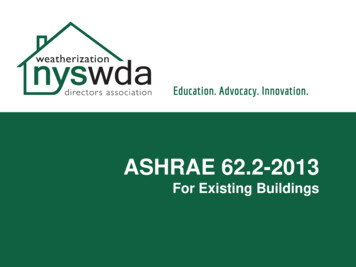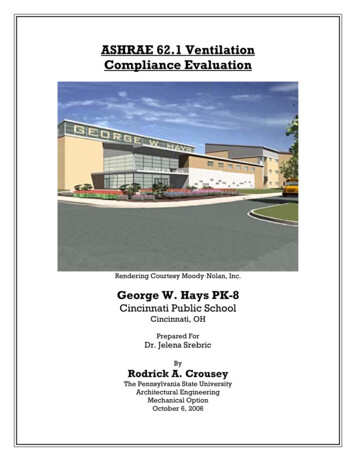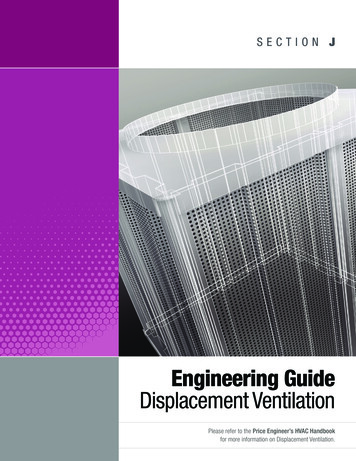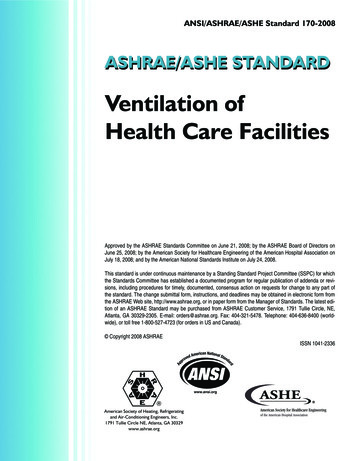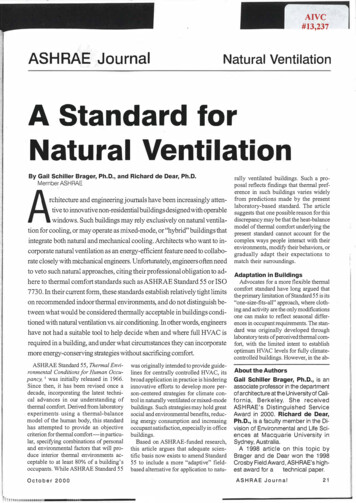
Transcription
AIVC#13,237ASHRAE JournalNatural VentilationA Standard forNatural VentilationBy Gail Schiller Brager, Ph.D., and Richard de Dear, Ph.D.Member ASH RAEAchitecture and engineering journals have been increasingly atten tive to innovative non-residential buildings designed with operablewindows. Such buildings may rely exclusively on natural ventila tion for cooling, or may operate as mixed-mode, or "hybrid" buildings thatintegrate both natural and mechanical cooling. Architects who want to in corporate natural ventilation as an energy-efficient feature need to collabo rate closely with mechanical engineers. Unfortunately, engineers often needto veto such natural approaches, citing their professional obligation to ad here to thermal comfort standards such as ASHRAE Standard 5 5 or ISO7730. In their current form, these standards establish relatively tight limitson recommended indoor thermal environments, and do not distinguish be tween what would be considered thermally acceptable in buildings condi tioned with natural ventilation vs. air conditioning. In other words, engineershave not had a suitable tool to help decide when and where full HVAC isrequired in a building, and under what circumstances they can incorporatemore energy-conserving strategies without sacrificing comfort.ASHRAE Standard 55, Thermal Envi ronmental Conditions for Human Occu 1 was initially released in 1966.Since then, it has been revised once adecade, incorporating the latest techni cal advances in our understanding ofthermal comfort. Derived from laboratoryexperiments using a thermal-balancemodel of the human body, this standardhas attempted to provide an objectivecriterion for thermal comfort-in particu lar, specifying combinations of personaland environmental factors that will pro duce interior thermal environments ac ceptable to at least 80% of a building'soccupants. While ASHRAE Standard 55pancy,October 2000was originally intended to provide guide lines for centrally controlled HVAC, itsbroad application in practice is hinderinginnovative efforts to develop more per son-centered strategies for climate con trol in naturally ventilated or mixed-modebuildings. Such strategies may hold greatsocial and environmental benefits, reduc ing energy consumption and increasingoccupant satisfaction, especially in officebuildings.Based on ASHRAE-funded research,this. article argues that adequate scien tific basis now exists to amend Standard55 to include a more "adaptive" field based alternative for application to natu-rally ventilated buildings. Such a pro posal reflects findings that thermal pref erence in such buildings varies widelyfrom predictions made by the presentlaboratory-based standard. The articlesuggests that one possible reason for thisdiscrepancy may be that the heat-balancemodel of thermal comfort underlying thepresent standard cannot account for thecomplex ways people interact with theirenvironments, modify their behaviors, orgradually adapt their expectations tomatch their surroundings.Adaptation in BuildingsAdvocates for a more flexible thermalcomfort standard have long argued thatthe primary limitation of Standard 55 is its"one-size-fits-all" approach, where cloth ing and activity are the only modificationsone can make to reflect seasonal differ ences in occupant requirements. The stan dard was originally developed throughlaboratory tests of perceived thermal com fort, with the limited intent to establishoptimum HVAC levels for fully climate controllea buildings. However, in the abAbout the AuthorsGail Schiller Brager, Ph.D., is anassociate professor in the departmentof architecture at the University of Cali f o r n i a,B erke ley.S h e receivedASHRAE's Distinguis hed ServiceAward in 2000. Richard de Dear,Ph.D., is a faculty member in the Di vision of Environmental and Life Sci ences at Macquarie University inSydney, Australia.A 1998 article on this topic byBrager and de Dear won the 1998Crosby Field Award, ASHRAE's highest award for atechnical paper.ASH RAE Journal21
ASHRAE Journalsence of any credible alternative, Standard 55 is applied univer m1tion of the evo ked response. [t al o includes the idea that asally across all building types, climates and populations.person's reaction to a temperature that is les than perfect willAs a consequence, even in relatively mild climatic zones, it is depend on ex pectation and on what that per on i doing at thehard to meet the standard's narrow definition of thermal com time.6fort without mechanical systems. Many researchers and de signers have argued, for example, that reliance on Standard 55 Research Methodshas allowed impo1iant cultural, social and contextual factors toThe research described in this a1iicle involved assembling abe ignored, leading to an exaggeration of the "need" for air quality-controlled database containing 21,000 sets of raw dataconditioning.2 Others have argued that allowing people greater compiled from previous thermal comfort field experiments in control of indoor enviromnents, and allowing temperatures to side 160 different office buildings located on four continentsmore closely track patterns in the outdoor climate, could im and covering a broad spectrum of climatic zones.7 The genderprove levels of occupant satisfaction with indoor environments and age distribution of the subjects was typical of office build and reduce energy consumption.3ing populations. The large sample size reduced the risk of biasSuch issues have particular relevance with regard to natu that might occm' in relatively smaller samples used in climaterally ventilated buildings, where occupants are able to open chamber experiments. The data included a full range of bothwindows, creating indoor conditions that are inherently more subjective and physical measurements, including thermal ques variable than buildings with centralized HVAC systems. In such tionnaire responses, clothing and metabolic estimates, concursettings, an alternative ther rent indoor climate measuremal comfort standard basedments, a variety of calculated"Many resear chers and desi gner s haveon field measurements mightthermal indices and outdoorbe able to account for contex ar gued . that reliance on Standar d 55 has almeteorological observations.tual and perceptual factorsAnalysis of data was per lowed important cultural, social and contextualabsent in the laboratory set formed separately for build ting. Toward this end, the re ings with centralized HVACfac tors to be ignored, leading to an exaggerationsearch began by focusing onsystems and natllrally venti three primary modes of adap of the "need" for air conditioning. Others have ar lated buildings (i.e., wheretation: physiological, behav occupants had access to op gued that allowing peop le greater control of inioral and psychologic l.erable windows). The analy Physiological adaptation,sis examined thermal comfortalso known as acclimatization, door environments, and al lowing temperatures to responses in terms of bothrefers to biological responses more closely track patterns in the out door climate,thermal neutrality and prefer that result from prolonged ex ence, as functions of both in posure to characteristic and could improve levels of occupant satisfaction withdoor and outdoor tempera relatively extreme thermal con tures. Observed responsesditions. One example in hot indoor environments and reduce ener gy con also were compared to predicclimates is a fall in the setpointtions of thermal sensation cal sump tion."body temperature at whichculated using the heat-bal sweating is triggered, leadingance-based PMV model. 8 Theto an increased tolerance for warmer temperatures. Laboratory PMV model is the basis for ISO Standard 7730,9 and for the nextevidence suggests, however, that such acclimatization does version of Standard 55.not play a strong role in subjective preferences across the mod The following sections present select aspects of the researcherate range of activities and thermal conditions present in most that directly relate to the proposal for an "adaptive" thermal com fort standard to be used as an alternate to PMV for naturallybuildings.4Behavioral adaptation refers to any conscious or unconscious ventilated buildings in the next revision of Standard 55. A moreaction a person might make to alter their body's thermal bal detailed description of the research methods, statistical analysisance5. Examples include changing clothes or activity levels, techniques and results can be found in ASHRAE Transactions.,1·rnturning on a fan or heater, or adjusting a diffuser or thermostat.Behavioral adjustments offer the best opportunity for people HVAC vs. Naturally Ventilated Buildingsto participate in maintaining their own thermal comfort. Afford To what extent do people behaviorally adapt in the two build ing ample opportunities for people to interact with and control ing types? Behavioral adaptation was analyzed by examiningthe indoor climate is an essential strategy in the design of natu how changes in clothing, metabolic rate and air velocity variedas functions of indoor temperature. Mean metabolic rates inrally ventilated buildings.The psychological dimension of thermal adaptation refers to both building types stayed fairly constant at about 1.2 metan altered perception of, and reaction to, physical conditions units regardless of indoor temperature, ranging within a fairlydue to past experience and expectations. It is premised on the tight cluster of 1.1-1.4 met units. In contrast, changes in cloth generalization, true across all sensory modalities (not just ther ing and air velocity were both significantly related to changesmal), that repeated exposure to a new stimulus leads to a dimi- in mean indoor operative temperatures in all buildings.22ASH RAE Journalwww.ash raejournal . orgOctober 2000
Mean clothing insulation values (including the incrementalinsulation of the chairs) varied seasonally in both building types.Summer vs. winter mean values were 0.70--D.92 clo in the HVACbuildings, compared to 0.66-D.93 in the naturally ventilatedbuildings.Althoughthesignificantly in terms of theirbuildingsmeandidn'tdifferclothing values, the totalrange of clothing worn was much much wider in the naturallyventilated buildings. Occupants of these buildings also dem onstrated a stronger relationship between their clothing pat terns and indoor temperature, with mean clothing insulationdecreasing by an average of 0.1 clo unit for every 2 C (3.6 F)increase in mean indoor temperature.Air velocity is considered a form of behavioral adaptationwhen people are able to make the environmental adjustmentsthemselves, such as opening or closing a window, turning on alocal fan, or adjusting an air diffuser. Mean air speeds recordedin the HVAC buildings generally were confined to the regionbelow 0.2 mis (39.4 :!pm), as prescribed in Standard 55-1992. In anaturally ventilated building, speeds above this limit were re corded when indoor temperatures extended beyond the uppertemperature limit of 26 C (78.8 F) in Standard 55-1992. As willbe shown later, however, these forms of behavioral adaptationcould account for only part of people's acceptance of highertemperatures in the naturally ventilated buildings.How do people react as conditions deviate from the optimum?A weighted linear regression model of the relationship betweenmean thermal sensation (TS) and mean indoor operative tem perature (T0 ) wa.s used to judgePwarm or too cool as temperatureshow quickly people felt toodeviated from the optimum:(Centralized HVAC buildings)TS 0.51TS 0.28xxT0PT0P-11.9621.03-(1)(T0 in C)P(T0 in F)P(Naturally ventilated buildings)TS 0.27 x Top - 6.65TS 0.15 x T0P -11.45(2)(T0 in C)P(T0 in F)PIn these equations, TS represents .a vote on the familiarASHRAE seven-point thenrial sensation scale, where TS O is"neutral." This analysis revealed that occupants of centralizedHVAC buildings were twice as sensitive to deviations in tem perature as were occupants of naturally ventilated buildings.Such a finding suggests that people in air-conditioned build ings have higher expectations for thermal consistency, andquickly become critical if thermal conditions diverge from theseYou need accurare and immediateexpectations. In contrast, people in naturally ventilated build answers to your questions. KnaufSings seem to demonstrate a preference for a wider range ofmade sure you'll always have accessthermal conditions, perhaps due to their ability to exert controlover their environment, or because their expectations matchthe more variable conditions they are used to experiencing insuch buildings.to.the answers y0u need, one way oranocher, 24 hours a day.How does one define a "comfort temperature?" Does every one always prefer to feel "neutral?" The traditional method ofdefining a comfortable temperature is to assume that a "neutralthermal sensation" represents ideal conditions, and then to.:dH:. .onReader Service Card)ASHRAE JournalOctober 2000.(Circle No. 31 -.: .: .23
I---- - -- -Nailor GOES TO "THE WALi!'FOR YOUINTRODUCING THE 1220 AIRFOIL COMBINATION FIRE/SMOKE DAMPER AN OPPORTUNITY TO FURTHER IMPROVE LIFE SAFETY AND REDUCE PROPERTY .DAMAGE!Low leakage fire/snwkedampers commonlyincorporate a syntheticblade-to-blade seal fin order tomaintain their leakage classunder elevated temperatureconditions - the srneK:e controlmode.The weakness until now hasbeen that when the damper issubjected to a fire condition theseals burn out. This permitssignificant leakage! In fact UL55Sstandard permits gaps be1'1yeenthe damper blades oi1!11@ td uring the fire test, thus I ow1n ,significant quantities of srrnoke topass through a closed d9mper :under fire conditions.3 t·Nailor's "The· Wall" providesan innovative inter-lrnskirng double-skin airfoil blade whicneliminates the need for seals."The Wall" maintains a completebarrler throughout the fire testwithabsolutely no visible through gaps.In fact. wh.en this desi§r-t wasrecently tested to ISO
ASHRAE Standard 55, Thermal Envi ronmental Conditions for Human Occu pancy, 1 was initially released in 1966. Since then, it has been revised once a decade, incorporating the latest techni cal advances in our understanding of thermal comfort. Derived from laboratory experiments using a thermal-balance model of the human body, this standard

